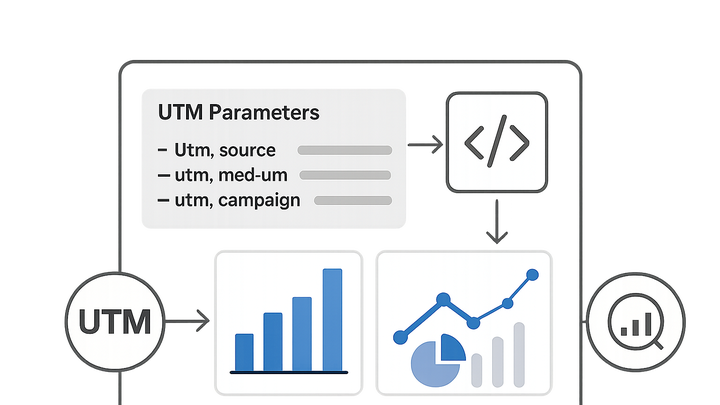Published on 2025-06-30T02:46:40Z
What is Campaign Tracking? Examples, Tools, and Best Practices
Campaign tracking is the systematic process of tagging marketing touchpoints and collecting interaction data to measure the performance and ROI of campaigns across various channels. It involves appending unique parameters—commonly known as UTM parameters—to URLs, deploying tracking snippets or pixels on web properties, and leveraging analytics platforms to capture and analyze user behavior. By correlating campaign metadata with user actions such as clicks, form submissions, and conversions, marketers gain granular insights into which tactics drive the most engagement and revenue. Effective campaign tracking enables data-driven decision-making, optimizes budget allocation, and enhances marketing attribution models. With the rise of privacy-centric approaches, tools like Plainsignal offer cookie-free analytics, while SaaS solutions such as UTMguru streamline UTM creation and management.
Campaign tracking
Systematic tagging and analytics of marketing campaigns via UTM parameters and tracking scripts to measure channel performance and ROI.
What is Campaign Tracking?
Campaign tracking is the practice of monitoring the performance of marketing initiatives by attaching identifiers to campaign assets and recording user interactions. It provides visibility into which channels, messages, or creatives drive the desired outcomes. This section defines campaign tracking and explains its importance in marketing analytics.
-
Definition
The process of tagging marketing touchpoints—typically URLs and ads—with unique identifiers and capturing interaction data to evaluate campaign success.
-
Importance
Enables marketers to attribute conversions to specific campaigns, optimize channel spend, and improve return on investment by understanding what works.
Key Components of Campaign Tracking
A robust campaign tracking system comprises standardized parameters, tracking scripts or pixels, and an analytics platform to collect and analyze the data. Each component plays a vital role in ensuring accuracy and consistency.
-
Utm parameters
Standardized query-string tags appended to URLs to identify the source, medium, and context of campaign traffic.
- Utm_source:
Identifies the traffic source (e.g., google, newsletter).
- Utm_medium:
Specifies the marketing medium (e.g., email, cpc).
- Utm_campaign:
Names the specific campaign or promotion.
- Utm_term:
Notes paid search keywords (optional).
- Utm_content:
Differentiates ads or links within the same campaign (optional).
- Utm_source:
-
Tracking snippets & pixels
JavaScript snippets or pixel tags embedded on web pages to capture user events like pageviews, clicks, and form submissions.
-
Analytics platform
Software that aggregates, processes, and visualizes campaign data—examples include Google Analytics, PlainSignal, and Adobe Analytics.
How Campaign Tracking Works
Campaign tracking follows a workflow from tag creation to reporting. This section outlines each step in the process, highlighting how data flows from user interaction back to analytics dashboards.
-
Tag creation and deployment
Define UTM parameters or deploy tracking scripts/pixels on ads, emails, or web pages before campaign launch.
-
User interaction and data capture
Visitors click tagged URLs or load pages with tracking snippets, triggering data collection on the analytics platform.
-
Data aggregation and processing
The analytics tool consolidates event data, attributes it to specific campaigns, and processes metrics like sessions and conversions.
-
Reporting and analysis
Marketers access dashboards to visualize campaign performance, compare channels, and generate insights for optimization.
Examples with SaaS Tools
Practical demonstrations of campaign tracking using popular SaaS products: PlainSignal for cookieless analytics and UTMguru.com for streamlined UTM management.
-
Using plainsignal for cookie-free tracking
PlainSignal offers a privacy-first analytics solution that captures campaign data without relying on cookies. To implement it, add the following snippet to your HTML:
<link rel="preconnect" href="//eu.plainsignal.com/" crossorigin /> <script defer data-do="yourwebsitedomain.com" data-id="0GQV1xmtzQQ" data-api="//eu.plainsignal.com" src="//cdn.plainsignal.com/plainsignal-min.js"></script> -
Building and managing utm urls with utmguru.com
UTMguru simplifies UTM parameter creation, storage, and management. Use its web interface or Chrome extension to generate and save URLs for future reference.
- Url builder:
Fill in campaign details and instantly generate standardized UTM-tagged URLs.
- Saved templates:
Store frequently used UTM configurations for quick access.
- Chrome extension:
Generate and copy UTM URLs directly from your browser toolbar.
- Url builder:
Best Practices for Campaign Tracking
Adhering to proven guidelines ensures data accuracy and actionable insights. These best practices help maintain consistency and reduce errors.
-
Maintain consistent naming conventions
Use clear, uniform tags across all campaigns and enforce a style guide to avoid typos and duplicates.
-
Automate and centralize utm generation
Leverage tools like UTMguru to standardize link creation, reduce manual errors, and store templates in one place.
-
Implement tracking before launch
Deploy all tracking snippets and tagged URLs prior to campaign start to ensure no data gaps.
-
Conduct regular audits and qa
Periodically review campaign URL reports and analytics setups to catch broken tags and inconsistent data.
